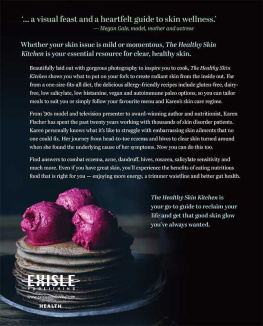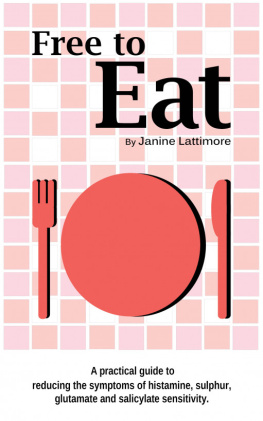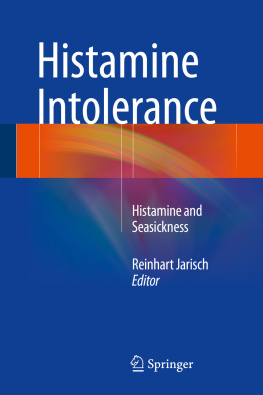Histamine Intolerance Cookbook
Low-Histamine Breakfast, Snacks, Appetizers, Soups, Main Course and Dessert Recipes for Histamine Intolerance
By Sally Lee
Copyright 2018 by Sally Lee
All rights reserved. This book or any portion thereof may not be reproduced or used in any manner whatsoever without the express written permission of the publisher except for the use of brief quotations in a book review.
This book is not intended as a substitute for the medical advice of physicians. The reader should regularly consult a physician in matters relating to his/her health and particularly with respect to any symptoms that may require diagnosis or medical attention.
No warranties are given in relation to the medical information presented in this Book. No liability will accrue to the writer and/or Book publisher in the event that the reader and/or user suffers any loss as a result of reliance, in part or in full, upon the information presented in this Book.
Table of Contents
I n a world filled with chronic fatigue, pain, and illness, the need for answers is common. One underappreciated factor that may be causing these symptoms is histamine intolerance. This condition goes hand-in-hand with inflammation, which, as most of us know, worsens illnesses and disease.
While many doctors do not yet understand how histamine intolerance works, it is slowly becoming accepted as research and is revealing more information about its related conditions, chronic urticaria (hives), and mast cell activation disorders, known as MCAS and MCAD. Some other illnesses that are known to have a histamine component are Parkinsons disease, chronic migraines, irritable bowel syndrome, heart diseases, multiple sclerosis, fibrillation, cancer, and Alzheimers disease.
Antihistamines may be utilized in easing some of the symptoms of this condition, but all too often, they are not enoughpeople still live with unmanaged symptoms that may become debilitating. Thankfully, the low-histamine and anti-inflammatory diets have been shown to greatly reduce the symptoms of histamine intolerance, guiding you to success and better health.
Histamines can affect your entire bodys system, and because of this, the symptoms are vast. If you live with rashes, flushing skin, hives, fatigue, itching, excessive sweating, bone and joint pain, headaches, tachycardia, eye pain, vertigo, low body temperature, an unexplained B12 deficiency, numbness or tingling, anxiety, low blood pressure, diarrhea, vomiting, hair loss, chest pain, sinus problems, shortness of breath, anaphylaxis, or any number of other symptoms, then you may possibly have a histamine intolerance.
In this cookbook, you will learn the basics of the low-histamine and anti-inflammatory dietalong with recipes for breakfast, snacks, appetizers, sides, salads, soups, stews, main dishes, and desserts that will help you reach success on your journey towards health.
Chapter 1: A Lower Histamine Diet
W hile histamine intolerance may sound like an allergy to histamines, this is not true, as histamines are a normal part of the human system. Histamine intolerance simply means that your body either produces too many histamines, is unable to rid itself of histamines and thus causing a buildup, or both.
Compared to most biological molecules, histamines are quite small, containing only seventeen atoms. However, this small molecule has a significant role in the human body and is involved in twenty-three various physiological functions. Histamines are able to be in such a variety of systems because they have a chemical property that allows them to be versatile in binding. Histamines carry a charge, are flexible, and are conformational, which aids in their ability to interact and bind to cells easily. Some of the functions histamines play a role in include vasodilation and blood pressure, the nasal mucous membrane, sleep-wake regulation, erection and sexual functioning, gastric acid release, and protection of the neurons.
Along with acting as a neurotransmitter in the brain, spinal cord, and uterushistamines regulate the physiological functioning of the gut and are most known for their significant role in the immune system. Histamines have a direct role in regulating inflammation and mediating itching.
In response to foreign pathogens, histamines are produced by mast cells and white blood cells known as basophils in nearby connective tissue. This release of histamines increases the ability of white blood cells to pass through the capillaries and allows them to fight off the pathogens in the infected tissues. The mast cells that produce these histamines are especially found in high quantity at areas that are more prone to injuries, such as the nose, mouth, blood vessels, skin, and feet. The histamines from the non-mast cell are found in multiple locations, including the brain, where they act as neurotransmitters.
The human body naturally produces these histamines and the diamine oxidase enzyme, DAO. Diamine oxidase is responsible for breaking down the histamines that are consumed through your diet. When something interferes with the DAOs functioning, then you develop histamine intolerance.
Some things that might affect your DAO enzyme could be medications, gastrointestinal disorders, bacterial overgrowth, high-histamine foods that trigger a malfunction of the DAO, and foods that specifically block the DAO enzyme or trigger the release of histamines.
Some foods that could trigger histamine intolerance are alcohol, tomatoes, chocolate, avocados, spinach, eggplant, shellfish, and cheese.
If you suspect that you may have a histamine intolerance, your doctor will begin to diagnose you by first eliminating other possible diagnoses and allergens that may cause similar symptoms. Doctors also often recommend following an elimination for 15 to 30 days, in order to remove any high-histamine foods and known triggers, before reintroducing the foods one by one while watching for allergic reactions or other symptoms.
Doctors may also use a blood test to analyze for a DAO deficiency or run a prick test. In one 2011 study on prick tests and histamine intolerance, it was found after testing one-hundred-fifty-six participants that the prick test is accurate in revealing a histamine intolerance 79% of the time.
While there are many symptoms of histamine intolerance, some of the most common ones include:
- Chronic headaches or migraines
- Diarrhea
- Flushing, especially of the face and chest
Next page












